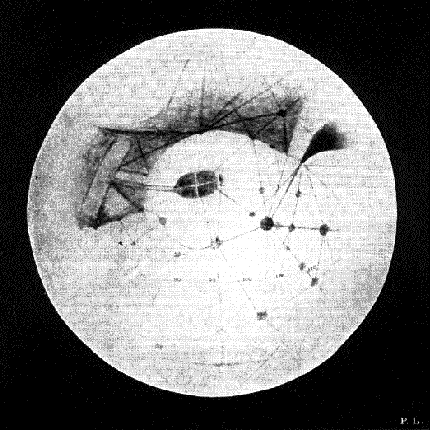
Lowell's Legacy- Part Three - Mars, Canvas of the Gods
"The fundamental fact in the matter is the dearth of water. If we keep this in mind, we shall see that many of the objections that spontaneously arise answer themselves. The supposed Herculean task of constructing such canals disappears at once; for, if the canals be dug for irrigation purposes, it is evident that what we see, and call by ellipsis the canal, is not really the canal at all, but the strip of fertilized land bordering it,--the thread of water in the midst of it, the canal itself, being far too small to be perceptible. In the case of an irrigation canal seen at a distance, it is always the strip of verdure, not the canal, that is visible, as we see in looking from afar upon irrigated country on the Earth. "
-Percival Lowell

Plate 6 from Lowell's 1894 Mars
opposition studies.
Mars at 90 degrees from the Meridian
Like Schiaparelli and others before
him Lowell recorded the Martian "canali" in detail. What processes
of our sister planet did these early observers witness and document? Is there
any good reason to assume what these professional astronomers all saw was for
some reason bogus?
What are these markings, clearly observable for several decades over a century
ago? Could we see them again in the next century? Are they gone forever? What
were they? Lowell described the markings as having a bluish tint.
"We may,
perhaps, in conclusion, consider for a moment how different in its details existence
on Mars must be from existence on the Earth. One point out of many bearing on
the subject, the simplest and most certain of all, is the effect of mere size
of habitat upon the size of the inhabitant; for geometrical conditions alone
are most potent factors in the problem of life. Volume and mass determine the
force of gravity upon the surface of a planet, and this is more far-reaching
in its effects than might at first be thought.
Gravity on the surface of
Mars is only a little more than one third what it is on the surface of the Earth.
This would work in two ways to very different conditions of existence from those
to which we are accustomed."
"To begin with, three times as much work, as for example, in digging a canal, could be done by the same expenditure of muscular force. If we were transported to Mars, we should be pleasingly surprised to find all our manual labor suddenly lightened threefold. But, indirectly, there might result a yet greater gain to our capabilities; for if Nature chose she could afford there to build her inhabitants on three times the scale she does on Earth without their ever finding it out except by interplanetary comparison."
-Percival Lowell
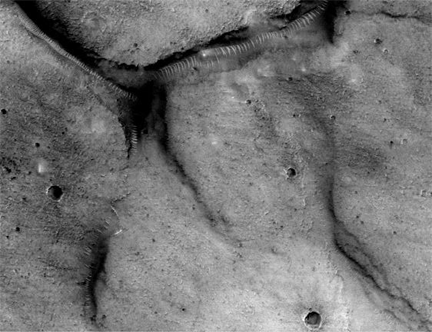
This image created a firestorm of controversy on the Internet which was reminiscent of the heated debate between Percival Lowell and members of the European astronomy community who adamantly disputed Lowell's contentions about Mars in the European press over a century ago.
Former NASA consultant Richard C. Hoagland
dubbed these unusual features the "Glass Tunnels of Mars".
Dr. David C. Pieri of the Jet Propulsion Laboratory quickly published a disclaimer,
stating these features were "simple Martian dune trains". Notables
such as Sir Arthur C. Clarke have commented on how unusual they seemed.
The tunnels are found in numerous
image strips and seem to be heavily distributed between 30 degrees and 40 degrees
north latitude. In fact they appeared in so many subsequently released image
strips that Mars appears rife with them in certain regions. Several articles
on these "Glass Tunnels" can be found at Johnny
Danger's Dangerous Mars Site and we will be analyzing several image strips
with these anomalies great detail later in this piece (per Lowell's elocutions).
Is this phenomenon the result of intelligent intervention or is it somehow related
to what Schiaparelli, Lowell, Green and others observed on Mars over a century
ago?
Mars enthusiast Eric C. Lausch
had been following developments on these purported "Glass Tunnels"
on the Internet and began to further study these unusual images. Lausch decided
after scrutinizing a close up of the "shiny spot" in the tunnel that
this was not an imaging artifact (it appears in the original data and appears
to be a light source) and published a short piece (with tongue in cheek) on
the Internet describing his take on this unusual image and coining the the phrase
"Giant Alien Mega-Dolphins" much to the chagrin and amusement of the
on-line anomaly community. Soon after this everything Mars was referred to in
good humor as Mega-Flora or Mega-Fauna.
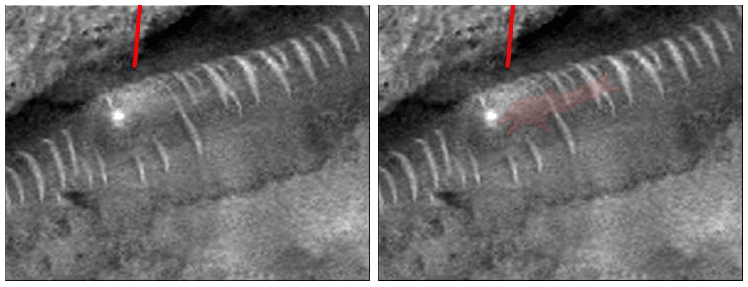
The Giant Alien Mega-Dolphin
Image courtesy of Eric C. Lausch and Kevin
Klettke
© 2001 Dangerzone productions
(Now for those of you who are rolling your eyes right now I'd like to reassure you that this has some relevancy to our overall theory that these tunnels are of artificial origin. Indeed, as this same spot on Mars has been re-imaged as a result of the FACETS litigation, the mega-dolphin and the shiny spot now become major research points for the purpose of comparison as this area has been so heavily scrutinized down to its very smallest details. The second image will be discussed in great detail near the end of this piece.)
Would that only Percival Lowell
himself could comment on this image. I can almost hear him lecturing about it.
The original piece can be found at http://www.geocities.com/Area51/Aurora/6664/analysis.htm
.
Needless to say this drew many
varied comments (mostly good-natured) from anomalists, dolphin lovers and science
pundits. Portions of the anomaly community accused Lausch of attempting
to sabotage their efforts to coerce NASA into
disclosure on all things Mars by impugning their highly vaunted credibility.
Over the past few years we have attempted to find other indications of these
Cetacean denizens on Mars (we looked at a lot of these glass tunnel images)
and while gigantic tube swimming dolphins are apparently somewhat scarce (and
the tunnels are predominately submerged except in certain locales) there are
other possible indications along similar cultural lines.
Which begs, I suppose, that we ask ourselves again what exactly this image represents? Can we believe our eyes even if as our rational thoughts tell us it cannot be? I've shown this image to hundreds of people (most of whom know little of Mars) and the overwhelming majority confess to seeing the dolphin and other entities in this particular Martian Rorschach test.
There are of course, several diverse lines of discussion here to follow.
In a nutshell:
A)It exists. It does not appear to be an
imaging artifact and can be found in the original data.
So it is an actual item on Mars whose physical characteristics allowed it to
be recorded in the visual light spectrum.
B) It is a living two hundred foot dolphin
swimming merrily along the Glass Tunnels of Mars.
Enchanting as this idea is, this is a leap of faith some people simply cannot
make even after acknowledging that they can see the dolphin in the image. As
David Jinks once said, "Yes! But there's no ####ing way!" Mega- Flipper
on Mars. It'd make a great Saturday afternoon kids show. Lowell would've been
proud. Most likely additional data and a couple of hundred tons of herring will
be required to further investigate this scenario.
C) The Mega-Dolphins, like the glass tunnel
anomalies represents a "class" of objects documented time and time
again on the surface of Mars, these being large scale effigies, pictograms and
intaglios. The dolphin in the tunnel is another example of culturally significant
Martian "landscape art" or effigy, similar to those made on Earth
by both ancient and modern human cultures.
Examples of terrestrial landscape art and effigies
Images Courtesy of J.P. Levassuer & E. C. Lausch
©
2004 Dangerzone productions
In this case for some it becomes a greater leap of faith to then avow the existence
of the glass tunnels. Numerous serious researchers who support and have tendered
theories about the Face at Cydonia as a culturally significant artifact, a large
scale work of art or effigy, do not yet subscribe to the possibility that these
tunnels are anything other than a mere sand dune as proposed by JPL. They buy
into the Martian effigy gig but not the glass tunnel diatribes. However,
their support of the effigy theory is equally duplicitous as they support the
eroded, ambigous Cydonia face as a cultural artifact yet dismiss other apparent
intaglios as a coincidence of topography and sun angle. Time and again we see
repeating instances of large anthropomorphic effigies in concert with our tunnel
complexes. The only plausible explanation for this is of course, intelligent
intervention, no matter what the subject matter of the representation, be it
human, extraterrestrial or cetacean.
This position creates a potential conflict of the anomalists logic. While advocating the possibility of landscape art on Mars (most notably in Cydonia), they cannot readily apply the same chain of reasoning that helped them to draw conclusions about the Face at Cydonia to Mega-Dolphin image due to it's inherent association with the glass tunnel anomalies (and the fact that defies everything they been taught about Mars) and the unlikeliness of the cetacean effigy. After all, even they know that no self respecting Martian landscape artist would waste time creating monuments on a sand dune!
However, to those enlightened individuals like Lowell and others, who've surmised the existence of system of large diameter, semitransparent tunnels or tubes crisscrossing the planet Mars (now chiefly below the surface) the feasibility of this being yet another example of large scale art work or effigy is a much shorter distance to leap across the chasm of faith. After all, with all those transparent surfaces on the tunnels, there'd be ample room for some decoration or perhaps even Martian graffiti. What more premium advertising space could one hope for than one of the few remaining spots that this system is still visible from the surface? It makes some sense, when taken in that context and can also be ascribed some measure of highly vaunted cultural significance, that is of course, assuming there was a culture there at one time which was responsible for creating such oddities as have been imaged in recent years.
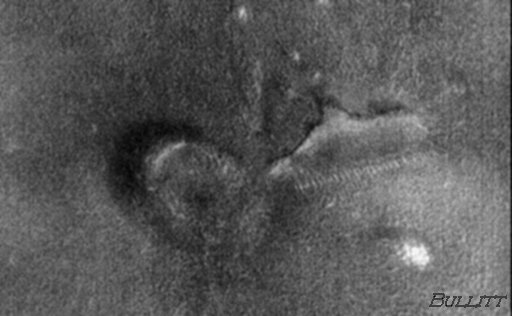
Cydonia- Dolphin Carving and Tunnel ribs
Image courtesy of Keith Laney
This image taken in the Cydonia region (SP122003) appears to show a gigantic carved dolphin on what could be a collapsed structure of some sort. Note the parallel sets of straight lines in front of this feature. Professor Stanley McDaniel called these features "The Coathanger". One could surmise that these are the ribs of one of our "Glass Tunnels" protruding above the Martian regolith passing alongside the enormous dolphin structure. Recalling that Cydonia's artifacts, per Lowell, have a 300 to 1 chance of being proven artificial with the inclusion of the tunnels, large effigies and structures, combined with the high incidence of groundwater should make NASA wonder what exactly this cluster of culturally significant artifacts around Cydonia represents.
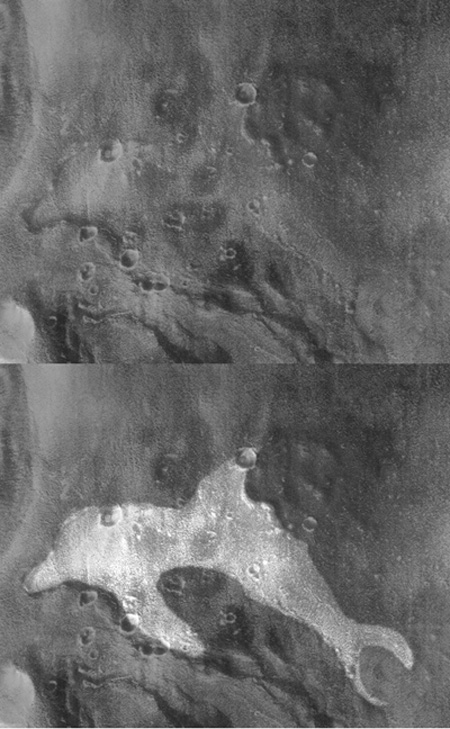
Dolphin intaglio at Cydonia Mensae
Image courtesy of US Taxpayer (Original comparison source unknown)
The frame above (also from the 1998 Cydonia Mensae images) shows a large Dolphin intaglio (complete with an ice filled crater as a blowhole!) directly adjacent to the Face and the other dolphin like anomaly at Cydonia. Are these pictograms worthy of greater scrutiny or imaginary dolphins in the sands? If this is pareidolia- an illusion or aberration of the mind, then why do we not see elephants and unicorns repeated over and over again in the shifting sands of Mars? The recurrence of the cetacean theme bears further investigation.
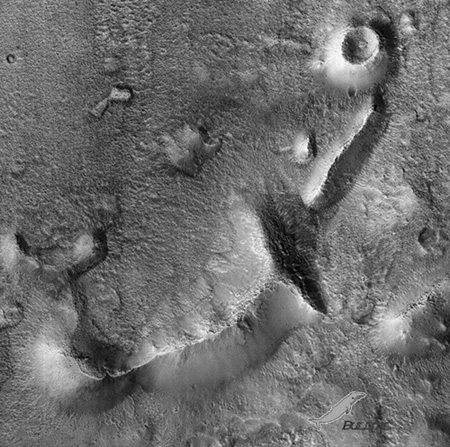
The Mega-Whale at Cydonia
MOC Image M0401903
Image courtesy of Keith Laney
Also from the Cydonia area, images
M0401903 and M0304566 yield a stylized whale rendering seen above and below
for clarification. It's apparently not a "trick of light and shadow"
as it appears in two different image strips. You'll note that the grayscale
image has a collapsed dome at the whales snout, looking for all of Mars like
some mega-beachball.
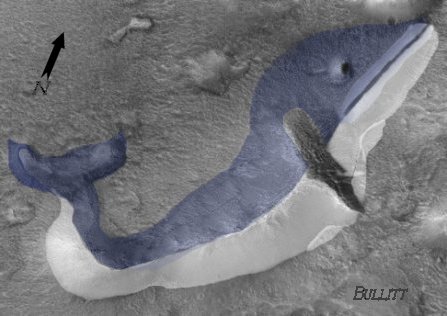
Images courtesy of Keith Laney
Image M1501765 (below) shows
what appears to a gigantic Nazca- like dolphin pictogram. This is getting
pretty fishy! (Sorry I had to think it-and yes Cetaceans are mammals.)
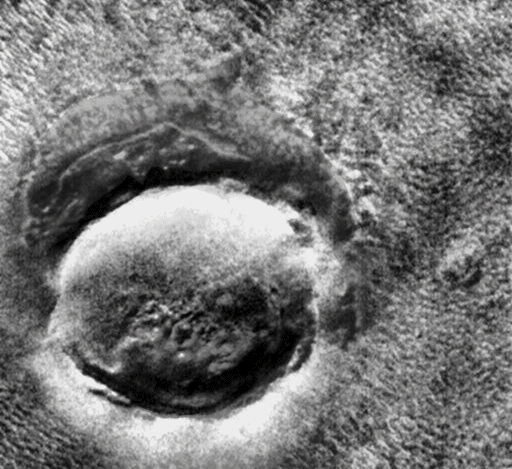
Dolphin pictogram from MOC Image M1501765
Lon -43.60¡ Lat 272.98¡
Resolution 1.43 m/pixel
Animated gif courtesy of Keith Laney
And of course we must include the anatomically correct dolphins and whales of MOC image E12-0072, the potential MER 2003 candidate site and the same image where we noted similarities between Lausch's potential "water works" plant from this strip with McCann's "Port".
Unfortunately NASA didn't choose
this extremely interesting area on Mars for one of it's two lander missions.
According to Keith Laney, who served as NASA MER Rover technical consultant
for image enhancement, "They won't land in Dolphinville. Too much mud.
"
Laney , astronomer Tom Van Flandern , SPSR member John Levassuer , Eric C.
Lausch and others have located hundreds of what could be construed as ancient,
weathered pictograms on Mars. All have been ridiculed out of hand by the planetary
science community that depends so much on continued funding for their robotic
missions and weekly paychecks.
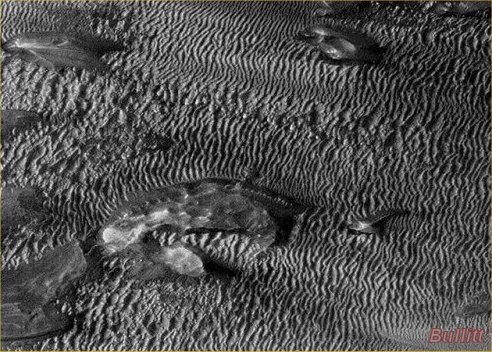
Crop of MOC Image E12-0072
Mega-Dolphins and Mega-Whales in Bas-relief
Image courtesy of Keith Laney
While Giant Alien Mega dolphins may seem somewhat outlandish, it is strangely compelling to find representations of familiar aquatic creatures from Earth on the surface of another planet. Remember, in addition to the Cetacean effigies the complete image strip E12-0072 appears to contain several other large structures (our "Port" type water reclamation facility) and what could be heavy equipment in the general vicinity. Lowell's probability states that there is a relationship between these apparent "water reclamation facilities" and the "glass tunnels" which are found in areas rich with underground water according to Gamma Ray Spectrometer readings.
An ancient aquatic preserve
serviced by a planetary wide water management system seems to suit this scenario
nicely. A civilization capable of a planetary scale civil engineering project
would almost certainly have had a similar facility with the arts as they did
with sciences and could conceivably have produced such enormous works of landscape
art.
Cetacean effigies in bas-relief
Image courtesy of Eric C. Lausch
© 2004 Dangerzone productions
Yet another crop from E12-0072, just north from from the whales and dolphins, seems to show us a jumbled, chaotic landscape. If as we proposed, this area was some type of reservoir, aquatic preserve or water management facility it seems reasonable to assume that the low lying areas in this image strip may have once been covered with standing water.
Crop of MOC Image E12-0072
By applying a splash of blue to the low lying areas we hoped to recreate how the area might have looked. The "waterline" reveals a surprising outline familiar to those from the Midwest or south eastern United States, the alligator snapping turtle. As this may seem rather subjective to the left brainers in the audience we will take this opportunity to point out that there is not just one, but three turtles (two adults and a hatchling) in the frieze. They appear to be bearing down on some wounded prey, which is desperate for escape. To anyone who's had first hand experience with alligator snappers and has seen how large and aggressive they they can become, this would seem a reasonable depiction of the snapper's carnivorous behavior.
Crop of MOC Image E12-0072
Mega-Snappers and Prey
Image courtesy of Eric C. Lausch
© 2004 Dangerzone productions
Indeed, the entire area shown in this strip with it's dolphins and turtles may have once been some type of large aquatic mural designed for overhead viewing of the aquapark. Capturing images of the adjacent areas to search for other similar effigies will be required to bear out this analysis. If this turns out to be the case in adjacent image strips, what possible explanations are there as to the meaning? One could attribute such turtlish perceptions to pareidolia,. a trick of light and shadow. However, its geographic proximity to the highly detailed whale carving and Lausch's "waterworks" facility would seem to support the contention that it is part of some larger civil engineering project. Unlike the transient dragon one sees in the clouds, these likeness' are frozen in stone, bearing mute testimony as to the history of Mars. Ancient cultural artifacts of a lost Martian civilization.
Percival Lowell would have been delighted at the thought enormous cetaceans and other creatures swimming lazily along one of Schiaparelli's "canali". One can imagine Lowell waxing poetic in regards to this recurring theme being portrayed in carvings and pictograms on the surface of the angry red planet. Ah, if only Lowell could see what closer inspection of Mars has brought to light! His interplanetary comparisons might not seem so fantastic as they did in the late nineteenth century.
Reiterating Lowell's thoughts on this:
"for
if Nature chose she could afford there to build her inhabitants on three times
the scale she does on Earth without their ever finding it out except by interplanetary
comparison."
-Percival Lowell
MOC image strip M15-01228 illustrates
another decidedly fishy construct with it's "Oannes" effigy, a humanoid
head morphing into a fish somewhat resembling a prehistoric coelacanth. While
hardly cetacean in nature, this artificial construct definitely bespeaks a
continued aquatic theme played out on the surface of Mars and an ongoing relationship
between these effigies, Martian landscape art and the glass tunnel anomalies.
"Oannes" effigy at Grand Central
Image courtesy of Eric C. Lausch and
Kevin Klettke
© 2004 Dangerzone productions
Is it conceivable that Mars was
long ago "the canvas of the Gods", with large scale works of landscape
art and gigantic effigies dotting its surface like some Martian Disneyland?
A twenty first century Percival Lowell might have suggested that the cetacean
effigies were advertising for an ancient aquarium or some Martian version
of "Seaworld" and the "Oannes" effigy was an entry que
for gaining admission to the underground oceans of Mars via the tunnel system.
A proverbial "E ticket ride" for Edgar Rice Burroughs to hand to
John Carter.
The incidence of large scale effigies, pictograms, intaglios and other seemingly
artificial constructs on Mars is becoming endemic to the point that it requires
some real investigation by our taxpayer funded government science entities.
The test of artificiality will most likely only be resolved with a sustained
human presence on Mars. The possibility that these images really do represent
an aquatic theme laid down by a lost civilization would not have escaped Percival
Lowell. Contemporary science would benefit from similar open-mindedness.
Should we believe what our eyes tell us we are seeing in these images? Or is this pareidolia?
Pareidolia is the unique human
ability to see dragons in the clouds or, as in this case, dolphins in the
sands. When viewing terrestrial black and white satellite images one does
not readily see such large intaglios dotting Earth's landscape. Why should
images from another planet prove so deceptive to our ilk? If these anthropomorphic
shapes are not the product of an over active psyche it then follows they are
exactly what they seem to be. Enormous renderings of aquatic creatures on
the surface of Mars created by artists unknown.
"For answers to such problems we must look to the future. That Mars seems to be inhabited is not the last, but the first word on the subject. More important than the mere fact of the existence of living beings there, is the question of what they maybe like. Whether we ourselves shall live to learn this cannot, of course, be foretold. One thing, however, we can do, and that speedily: look at things from a standpoint raised above our local point of view; free our minds at least from the shackles that of necessity tether our bodies; recognize the possibility of others in the same light that we do the certainty of ourselves. That we are the sum and substance of the capabilities of the cosmos is something so preposterous as to be exquisitely comic. We pride ourselves upon being men of the world, forgetting that this is but objectionable singularity, unless we are, in some wise, men of more worlds than one. For, after all, we are but a link in a chain. Man is merely this earth's highest production up to date. That he in any sense gauges the possibilities of the universe is humorous. He does not, as we can easily foresee, even gauge those of this planet. He has been steadily bettering from an immemorial past, and will apparently continue to improve through an incalculable future. Still less does he gauge the universe about him. He merely typifies in an imperfect way what is going on elsewhere, and what, to a mathematical certainty, is in some corners of the cosmos indefinitely excelled.
If astronomy teaches anything, it teaches that man is but a detail in the evolution of the universe, and that resemblant though diverse details are inevitably to be expected in the host of orbs around him. He learns that, though be will probably never find his double anywhere, he is destined to discover any number of cousins scattered through space."
-Percival Lowell
In the next section we shall take a look at the definition of pareidolia and
compare possible Martian artifacts to terrestrial analogues in an attempt
to quantify these disturbing images that defy conventional explanation as
Johnny Danger's Dangerous Martian Rorschach test
continues.